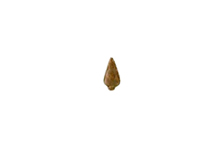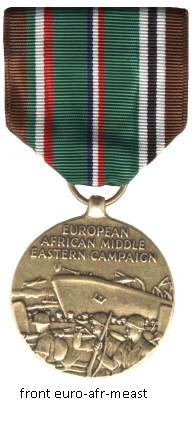 |
Men of the 540th were awarded the Bronze
Service Arrowhead device for their participation in Operation Torch, Morocco,
8-11th, November, 1942 while others were recognized for their role in
Operation Husky in Sicily, and Operation Avalanche in Salerno. The
arrowhead is awarded but once.
 The phrase
"with arrowhead" is used on Lineage and Honors Certificates to indicate that
a unit participated in an assault landing, either amphibious or airborne,
during that campaign. This is represented on the campaign streamer by an
embroidered arrowhead.
Criteria:
The Bronze Star Arrowhead is a
bronze replica of an Indian arrowhead 1/4 inch high and which denotes
participation in a combat parachute jump, helicopter assault landing, combat
glider landing, or amphibious assault landing, while assigned or attached as
a member of an organized force carrying out an assigned tactical mission. A
soldier must actually exit the aircraft or watercraft to receive assault
credit.
Individual assault credit is
tied directly to the combat assault credit decision for the unit to which
the soldier is attached or assigned at the time of the assault. Should a
unit be denied assault, no assault credit will accrue to the individual
soldiers of the unit.
It is worn on the service and
suspension ribbons of the Asiatic-Pacific Campaign, European-Africa-Middle
Eastern Campaign, Korean Service Medal, Vietnam Service Medal and Armed
Force Expeditionary Medal. Only one arrowhead will be worn on any ribbon. |
Pvt. Gardner landed at Safi, French Morocco, with the 2nd Battalion, 540th
Combat Engineer Regiment, U.S. Army. For the Safi landing, he was awarded
a bronze "assault" arrowhead and the first of seven
bronze battle stars.
Mr. Gardner's World War II campaign history reads like a modern-day
tourist brochure; Algeria-French Morocco, Sicily, Naples-Foggia, Rome-Arno,
Southern France, Rhineland and Central Europe. In five of these seven WWII
campaigns, his combat engineers were there for D-Day, both numbers being quite
remarkable. Pvt. Gardner military service duties and experience was in the European
Theater of WWII over a historic 5 year period (1941-1946). There were 16
WWII campaigns in the European - African - Middle Eastern Campaign Medal Ribbon,
others: Egypt-Libya, Air Offensive Europe, Tunisia, Anzio, Normandy, Northern
France, Northern Apennines, Ardennes-Alsace, Po Valley.
Operation Torch in Morocco,
The Western Task Force landed before daybreak on 8 November 1942, at three
points in Morocco: Safi (Operation Blackstone), Fedala (Operation Brushwood) the
largest landing with 19,000 men), and Mehdiya-Port Lyautey (Operation Goalpost).
Because it was hoped that the French would not resist, there were no preliminary
bombardments. This proved to be a costly error as French defenses took a toll of
American landing forces.
Operation Blackstone was Safi
part of Operation Torch. The Allies planned a three-pronged amphibious landing
to seize the key ports and airports of Morocco and Algeria simultaneously,
targeting Casablanca, Oran and Algiers. Operation Husky in Sicily, and
Operation Avalanche in Salerno were part of the bigger plan.
In the Morocco landing on 8-11 November,1942 Major General George S.
Patton, Jr., as the landing force commander, under General Eisenhower launched
amphibious assaults as Western Task Force, a 3 prong landing from the Atlantic
Ocean onto beaches of French Morocco and the Safi Landing being one of those.
Other task forces where also attacking, like Central Task Force and Eastern Task
who were making assault beach landings from the Mediterranean Sea into Algeria.
Walter Gardner

